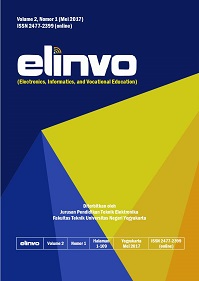Classification of Beef and Pork Images Based on Color Features and Pseudo Nearest Neighbor Rule
DOI:
https://doi.org/10.21831/elinvo.v8i2.64810Keywords:
pseudo nearest neighbor rule, classification, color features, beef and pork, halal foodAbstract
References
C. Reviews, "Impact of Pork Consumption on Human Health," vol. 7, no. 03, pp. 2442–2447, 2020.
S. A. Laga and R. Sarno, "Optimal sample temperature of electronic nose for detecting beef and pork mixture," 2019 International Conference on Information and Communications Technology, ICOIACT 2019, pp. 398–402, 2019, doi: 10.1109/ICOIACT46704.2019.8938492.
R. Sarno, K. Triyana, S. I. Sabilla, D. R. Wijaya, D. Sunaryono, and C. Fatichah, "Detecting Pork Adulteration in Beef for Halal Authentication using an Optimized Electronic Nose System," IEEE Access, vol. 8, pp. 25–30, 2020, doi: 10.1109/ACCESS.2020.3043394.
I. Tazi, N. Laila Isnaini, and A. Ainur, "Principal Component Analysis (PCA) Method for Classification of Beef and Pork Aroma Based on Electronic Nose," Indonesian Journal of Halal Research, vol. 1, no. 1, pp. 5–8, 2019, doi: 10.15575/ijhar.4155.
D. R. Wijaya, R. Sarno, and A. F. Daiva, "Electronic nose for classifying beef and pork using Naí¯ve Bayes," Proceedings - 2017 International Seminar on Sensor, Instrumentation, Measurement and Metrology: Innovation for the Advancement and Competitiveness of the Nation, ISSIMM 2017, vol. 2017-Janua, pp. 104–108, 2017, doi: 10.1109/ISSIMM.2017.8124272.
U. Sudibyo, D. P. Kusumaningrum, E. H. Rachmawanto, and C. A. Sari, "OPTIMASI ALGORITMA LEARNING VECTOR QUANTIZATION (LVQ) DALAM PENGKLASIFIKASIAN CITRA DAGING SAPI DAN DAGING BABI BERBASIS GLCM DAN HSV," Jurnal SIMETRIS, vol. 9, no. 1, 2018.
J. Jasril and S. Sanjaya, "Learning Vector Quantization 3 (LVQ3) and Spatial Fuzzy C-Means (SFCM) for Beef and Pork Image Classification," Indonesian Journal of Artificial Intelligence and Data Mining, vol. 1, no. 2, p. 60, 2018, doi: 10.24014/ijaidm.v1i2.5024.
E. I. Sela and Sutarman, "Extracting the potential features of digital panoramic radiograph images by combining radio morphometry index, texture analysis, and morphological features," Journal of Computer Science, vol. 14, no. 2, pp. 144–152, 2017, doi: 10.3844/jcssp.2018.144.152.
E. I. Sela and R. Pulungan, "Osteoporosis identification based on the validated trabecular area on digital dental radiographic images," Procedia Comput Sci, vol. 157, pp. 282–289, 2019, doi: 10.1016/j.procs.2019.08.168.
S. Ayu Aisah, A. Hanifa Setyaningrum, L. Kesuma Wardhani, and R. Bahaweres, "Identifying Pork Raw-Meat Based on Color and Texture Extraction Using Support Vector Machine," 2020 8th International Conference on Cyber and IT Service Management, CITSM 2020, no. c, 2020, doi: 10.1109/CITSM50537.2020.9268892.
L. Handayani et al., "Comparison of target Probabilistic Neural network (PNN) classification for beef and pork," J Theor Appl Inf Technol, vol. 95, no. 12, pp. 2753–2760, 2017.
O. D. Nurhayati and I. P. Hastuti, "Metode Moment Invariant Geometrik untuk Menganalisis Jenis Daging Babi dan Daging Sapi," Jurnal Sistem Informasi Bisnis, vol. 8, no. 2, p. 67, 2018, doi: 10.21456/vol8iss2pp67-72.
J. Chairunnisa et al., "Pork and Beef Features Extractions," Proceedings - 2018 International Seminar on Application for Technology of Information and Communication: Creative Technology for Human Life, iSemantic 2018, pp. 295–298, 2018, doi: 10.1109/ISEMANTIC.2018.8549765.
K. Adi, S. Pujiyanto, O. D. Nurhayati, and A. Pamungkas, "Beef Quality Identification using Color Analysis and K-Nearest Neighbor Classification," in 2015 4th International Conference on Instrumentation, Communications, Information Technology, and Biomedical Engineering (ICICI-BME), Bandung, 2015, pp. 180–184.
Y. Zeng, Y. Yang, and L. Zhao, "Pseudo nearest neighbor rule for pattern classification," Expert Syst Appl, vol. 36, no. 2 PART 2, pp. 3587–3595, 2009, doi: 10.1016/j.eswa.2008.02.003.
Downloads
Published
How to Cite
Issue
Section
Citation Check
License
The article published in ELINVO became ELINVO's right in publication.
This work by ELINVO is licensed under a Creative Commons Attribution-NonCommercial 4.0 International License.








